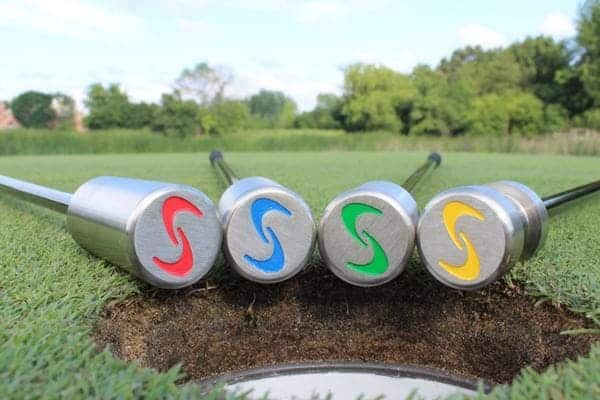Swing speed is one of the biggest buzzwords that’s talked about in the world of golf today.
American Bryson DeChambeau sparked the conversation way back in 2019 when he actively started documenting his journey towards gaining extra clubhead speed and ball speed through an intense training regimen.
He quickly bulked up his body and added many miles-per-hour to his driver swing, culminating in massive distance gains that, ultimately, led to him winning the 2020 US Open at Winged Foot with a now infamous ‘bomb and gouge’ strategy.
More recently, Englishman Matt Fitzpatrick credited speed training as a big reason for him winning the 2022 US Open in Brookline, after he spent many months working on increasing his clubhead speed and distance to give himself shorter approach shots into greens.
So, is golf speed training worth it? And will it make you a better play?
Golf speed training is absolutely worthwhile if you wish to become a better player. Data clearly shows the longer you hit the ball, the lower your handicap is likely to be due to having shorter approach shots into greens. If you can increase clubhead speed, and therefore distance, you will score better.
It’s no surprise that both DeChambeau and Fitzpatrick won their first major championships within years of beginning a targeted speed training regimen.
While the average golfer may not have the time to go to the extremes these two players did, there are still some things you can do that will have a dramatic impact on helping you gain swing speed.
Let’s dive in and take an in-depth look at speed training – what it is, how to do it, and the benefits it can bring to your game.
Table of contents
What is golf speed training?
Golf speed training is the process of repeatedly swinging at your limit, in a controlled environment, in an effort to increase your maximum clubhead speed each time and make incremental gains. Over time, your body will adjust and find it easier to swing at higher speeds than it did previously.
The best way to think of golf speed training is by comparing it to weight training.
When lifting weights, your goal is to exhaust your target muscles time and time again – every time they repair, they become a little stronger and you can continue slowly adding weight during each session.
Over the course of months and years, you will make significant strength gains and be able to lift far more weight than what you could when you first started.
Golf speed training is exactly the same.
You aren’t trying to make massive gains in every session – instead, by swinging the club as hard and as fast as you can during each session, your aim is to make tiny mile-per-hour gains (as few as 0.5 mph in some cases).
Over months and years, those tiny gains will add up to significant growth in overall clubhead speed.

How do you train for speed in golf?
To train for speed in golf, you need to start by using a club shaft without a driver head attached. After warming up, swing this as hard as you can for four repetitions. Then, move to a slightly heavier shaft. Again, swing as hard as you can for four repetitions. Move back to the lighter shaft, and repeat. Doing this three times per week can deliver significant speed gains in just a couple of months.
The best way to train for speed in golf is by using the SuperSpeed Golf Training System.
This system, which has been positively reviewed by thousands of golfers worldwide, comes with three specially-made club shafts that each have a small, colourful weight at the end – ranging from light, to medium, to heavy.
According to the manufacturer, completing only three 10-minute sessions with the SuperSpeed Golf Training System every week will typically improve your swing speed by over 5% in just 4-6 weeks.
How to train using the SuperSpeed Golf Training System
Long driver superstar Martin Borgmeier, who swings his driver at 155mph, has outlined one of the simplest training routines that you can follow using the SuperSpeed Golf Training System.
While the system does come with video demonstrating its own routine, Borgemeier – who as of late 2021 held the world record for ball speed with 231.9mph – has an easy-to-follow method that will work equally as well (and given his credentials, I’m more inclined to follow him).
His routine follows the use of a pyramid training scheme, starting with light weight, then moving to medium weight, then back to light weight. I’ve outlined it below:
Warm-up
- Take your lightest SuperSpeed club and do some gentle one-handed swings with both your right hand and left hand
- Make sure you do this on both sides of your body (swinging the club first as a right-handed player, and then as a left-handed player) as this will train both your dominant and non-dominant sides equally
Mindset
Before starting, be sure to remember Borgmeier’s two rules. 1) Focus on your power sources. 2) Don’t focus on technique.
It does not matter what your wrist angles or club path are doing, nor does it matter if your feet are doing crazy things.
The only thing that matters is you focus on where your power and energy is being generated from.

Training routine
Your training routine will consist of three blocks, each with six swings (starting light, moving to medium, then returning to light).
These blocks are as followed:
Block 1 (light weight)
- Make 1 x swing at 80 percent of your maximum
- Make 1 x swing at 90 percent of your maximum
- Make 4 x swings at 100 percent of your maximum, straight after the other
Block 2 (medium weight)
- Make 1 x swing at 80 percent of your maximum
- Make 1 x swing at 90 percent of your maximum
- Make 4 x swings at 100 percent of your maximum, straight after the other
Block 3 (light weight)
- Make 1 x swing at 80 percent of your maximum
- Make 1 x swing at 90 percent of your maximum
- Make 4 x swings at 100 percent of your maximum, straight after the other
And that’s all there is to it! Complete this 3-part training block three times per week, and you will almost certainly make speed gains out on the course.
As you start getting stronger and make improvements, you can swap out the clubs to a medium-heavy-medium split, rather than a light-medium-light split (however, make sure you warm up sufficiently before attempting this).
If you want some more advanced moves, you can try stepping into your lead leg as you begin your downswing (much like a baseball pitcher), or even focus on making your backswing as fast as possible as well.
Watch the complete video from Borgmeier below for a full visual explanation of these drills:
Does golf speed training actually work?
Golf speed training absolutely works when done correctly over a long period of time (many weeks or months). Even amateur players have reported speed gains of up to 15mph with their driver after participating in training programs such as the SuperSpeed Golf Training System, while many Tour pros have also seen similar results.
Anyone who says speed training doesn’t work is either 1) not telling the truth, or 2) failed to apply themselves to the training for long enough to see decent results.
If you use the SuperSpeed Golf Training System for at least six weeks – and make sure you swing at your absolute maximum when required to as part of the training blocks – you will almost certainly gain many miles-per-hour of extra clubhead speed.
Having read testimonials from dozens of people who have used it, some have gained as much as 15mph with their driver, which has translated to more than 30 extra yards of distance on their tee shots.
What exercises increase swing speed in golf?
To increase swing speed in golf, you want to focus on exercises than strengthen your core and legs. These are two areas that help generate power but also stability in your swing.
According to PGA coach Thor Parrish, the six best exercises you can do in the gym to increase your swing speed include:
- Battles Ropes
- 90-Degree Box Jumps
- Medicine Ball Slams
- Thrusters
- Kettlebell Snatches
- Kettlebell Swings
Each of these dynamic movements will build strength in your core and legs, which will have a positive effect on your game.
You can watch Thor explain how to do them in a video here.
Is golf speed training worth it?
Yes, golf speed training is absolutely worth it. If you are serious about shooting lower scores and lowering your handicap, you need to increase your distance off the tee. Hitting longer drives is proven to correlate with lower scoring, which is why speed training is crucial if you wish to become a better player.
While there are a few ‘shorter’ hitters on the PGA Tour, most of the best golfers in the world can drive the ball 300+ yards if swinging at 100 percent of their maximum.
Of course, these are the most elite group of players on the planet and it’s not realistic to think you can match them with a few weeks of speed training – however, the point I’m trying to show is that the longer you hit the ball off the tee, the shorter approach shots you’ll have into the green.
USGA data analysis of amateur golfers (skip to page 20) shows that if you can drive the ball farther than 220 yards on average, your odds of becoming a single figure golfer improve dramatically.
So, by applying yourself to speed training and becoming a longer hitter, you give yourself far better chance of shooting in the 70s, or lower.
Final message
If you want to become a longer hitter in golf, speed training is one way that you can do so without needing to flog yourself in the gym for hours on end.
Using the SuperSpeed Golf Training System just three times a week, for 10 minutes each time, could see you gain 5% more swing speed with your driver (not bad for just a half hour of work every seven days).
Tour players like Bryson DeChambeau and Matt Fitzpatrick have shown the massive benefits it can have at the elite level, with the same principles able to be applied at an amateur level – with players like you and I able to reap the rewards, should we apply ourselves and put in the hard work.


